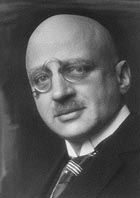 Fritz
Haber was born
on December 9, 1868 in Breslau, Germany, in one of the oldest families
of the town, as the son of Siegfried Haber, a merchant. He went to
school at the St. Elizabeth classical school at Breslau and he did,
even while he was at school, many chemical experiments.
Fritz
Haber was born
on December 9, 1868 in Breslau, Germany, in one of the oldest families
of the town, as the son of Siegfried Haber, a merchant. He went to
school at the St. Elizabeth classical school at Breslau and he did,
even while he was at school, many chemical experiments.From 1886 until 1891 he studied chemistry at the University of Heidelberg under Bunsen, at the University of Berlin under A.W. Hoffmann, and at the Technical School at Charlottenburg under Liebermann. After completing his University studies he voluntarily worked for a time in his father's chemical business and, being interested in chemical technology, he also worked for a while under Professor Georg Lunge at the Institute of Technology at Zurich. He then finally decided to take up a scientific career and went for one and a half years to work with Ludwig Knorr at Jena, publishing with him a joint paper on diacetosuccinic ester. Still uncertain whether to devote himself to chemistry or physics, he was offered in 1894, and accepted, an assistantship at Karlsruhe by the Professor of Chemical Technology there, Hans Bunte. Here he remained until 1911. Bunte was especially interested in combustion chemistry and Carl Engler, who was also there, introduced Haber to the study of petroleum and Haber's subsequent work was greatly influenced by these two colleagues.
In 1896 Haber qualified as a Privatdozent with a thesis on his experimental studies of the decomposition and combustion of hydrocarbons and in 1906 he was appointed Professor of Physical Chemistry and Electrochemistry and Director of the Institute established at Karlsruhe to study these subjects.
In 1911 he was appointed to succeed Engler as Director of the Institute for Physical and Electrochemistry at Berlin-Dahlem, where he remained until, in 1933, the Nazi race laws compelled nearly all his staff to resign and Haber, rather than agree to this, himself resigned. He was then invited by Sir William Pope to go to Cambridge, England and there he remained for a while. He had, however, been suffering for some time from heart disease and, fearing the English winter, he moved to Switzerland.
In 1898 Haber published his textbook on Electrochemistry, which was based on the lectures he gave at Karlsruhe. In the preface to his book he expressed his intention to relate chemical research to industrial processes and in the same year he reported the results of his work on electrolytic oxidation and reduction, in which he showed that definite reduction products can result if the potential at the cathode is kept constant. In 1898 he explained the reduction of nitrobenzene in stages at the cathode and this became the model for other similar reduction processes.
There followed, during the next ten years, other electrochemical research. Among these was his work on the electrolysis of solid salts (1904), on the establishment of the quinone-hydroquinone equilibrium at the cathode, which laid the foundations for Biilmann's quinhydrone electrode for determining the acidity of a liquid; but Haber invented, in collaboration with Cremer, the glass electrode for the same purposes which is now widely used. This led Haber to make the first experimental investigations of the potential differences that occur between solid electrolytes and their aqueous solutions.
During this period Haber also studied the loss of energy by steam engines, turbines and motors driven by fuels, and sought methods of limiting their loss by electrochemical means. He did not succeed in finding a solution of this problem that was commercially applicable, but he did succeed in finding a fundamental solution for the laboratory combustion of carbon monoxide and hydrogen.
He then turned to the study of flames and did fundamental researches on the Bunsen flame, showing that, in the luminous inner cone of this flame, a thermodynamic water-gas equilibrium is established and that, in its outer mantle, there is combustion of water-gas. This led to a chemical method of determining flame temperatures.
Haber then undertook the work on the fixation of nitrogen from the air for which he was given the Nobel Prize in Chemistry for 1918 (awarded in 1919).